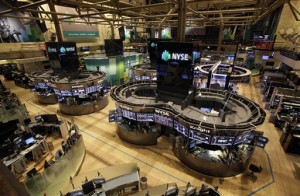
In this Monday, Oct. 29, 2012, file photo, the floor of the New York Stock Exchange is empty of traders, as New York’s financial district braced for the onslaught of Hurricane Sandy, which froze commerce, shut down stock exchanges for the first time since 9/11 and idled millions of workers. AP PHOTO/RICHARD DREW
WASHINGTON—Superstorm “Sandy” froze commerce, shut down stock exchanges for the first time since 9/11 and idled millions of workers on Monday, laying siege to an economy still trying to get out of first gear.
The US East Coast from North Carolina to Massachusetts, where a large portion of the US economy’s productive power is concentrated, was brought to a halt by the storm’s whipping winds and devastating storm surged.
The financial center of New York was vacated as bankers stayed home and the New York Stock Exchange (NYSE) and the Nasdaq market shut completely, warning that they would only resume trade on Wednesday, “conditions permitting.”
It was the first full trading closure since the September 11 attacks closed US equity markets for four days in 2001, and the first full NYSE shutdown due to weather since September 1985, when Hurricane “Gloria” closed it for a day.
Reports said more than 500,000 people and businesses were without power.
Oil refineries in the storm’s path were shut down and New Jersey nuclear plants said they would shut down if the winds and the storm surged in an adjacent river surpassed key thresholds.
With 20 percent of the country’s population under threat, disaster estimator Eqecat forecast that the massive storm could cause up to $20 billion in damage, only half of them insured.
That could hit an economy that has already been struggling to gather pace, with economic growth at 2 percent in the third quarter and the government battling to overcome an unemployment rate of 7.8 percent.
The storm also comes as President Barack Obama battles a strong challenge from Republican Mitt Romney, with the Nov. 6 election offering voters a choice between the very different economic plans mapped out by the two.
4 centers closed
Four major economic centers—New York, Washington, Philadelphia and Baltimore—were effectively closed, with mass transit and flights cut or halted completely, businesses shuttered and office workers forced to work from home.
Banks such as Bank of America and Goldman Sachs—located in low-lying areas of Manhattan that were ordered evacuated in the face of a flooding threat—shut their doors and transferred crucial operations to other offices.
Many companies who had expected to announce quarterly earnings put off their release, including Pfizer, McGraw-Hill and Thomson Reuters.
US federal workers were told to stay home a second day on Tuesday, raising some concerns that key economic data scheduled for release—the October jobs reports on Friday—might be delayed.
Fuel worries
With the jobs numbers likely to figure into the battle for the presidency, a labor department spokesperson said the agency was working hard to ensure the figures could be issued as planned.
Worries that fuel could be in short supply because of the shutdown of several oil refineries along the coast were downplayed, mainly because consumption was also sharply lower as drivers stayed home.
“Gas availability could be affected more from the threats of flooding,” said Stephen Rajczyk of the northern New Jersey branch of the motorists’ organization AAA.
But “prices should not be impacted by this due to less driving, businesses and schools closed, less economic activity in general,” he added.
Some played down the broader impact of the storm on the economy, saying that construction, trading and shopping would resume with a spurt afterward.
“Wealth destruction is bad, and Sandy could destroy billions in national wealth,” said Jason Schenker of Prestige Economics. “Nevertheless, while hurricanes and other natural disasters are extremely negative for wealth, they are usually positive for growth.”

